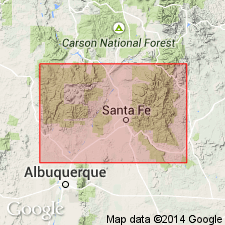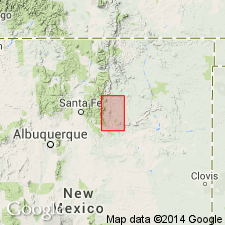
- Usage in publication:
-
- Turquillo Member*
- Modifications:
-
- Named
- Dominant lithology:
-
- Mudstone
- Conglomerate
- AAPG geologic province:
-
- Palo Duro basin
- Las Vegas-Raton basin
- San Luis basin
Summary:
Named as second from base of four members of Tererro Formation (revised) of Arroyo Penasco Group (here raised to group rank). Probably named for village of Turquillo; type section designated 4 mi south of village of Turquillo, on NM State Hwy 38 and 1/2 mi west on a logging road into a deep canyon, east side of Rincon Range, Mora Co, NM in Las Vegas-Raton basin. Disconformably overlies the eroded Osagean (Early Mississippian) Espiritu Santo Formation of Arroyo Penasco; in some places overlies Macho Member of Tererro. Underlies Manuelitas Member of Tererro in some places. Is a thick-bedded mudstone-wackestone, rich in foraminifers and bothrolites. At type section it consists of stromatolitic-spongiostromid wackestones only 2 m thick. Also present in sections measured: just east of Taos, Taos Co, San Luis basin; at Agua Zarca and in Gallinas Canyon, both in San Miguel Co, Palo Duro basin; in Lujan Canyon and at Mora Gap, both in Mora Co, Las Vegas-Raton basin. At the Mora Gap locality, formation contains widespread intraformational conglomerates. The abundant fauna indicates passage of Zone 12/13, which is Salem-St. Louis boundary age equivalent (Meramecian, Late Mississippian). Measured sections, correlation chart.
Source: GNU records (USGS DDS-6; Denver GNULEX).

- Usage in publication:
-
- Turquillo Member
- Modifications:
-
- Not used
Summary:
Not used in study area of southeastern Sangre de Cristo Mountains, Mora and San Miguel Cos, NM, Las Vegas-Raton and Palo Duro basins. Said to occur in study area by Armstrong and Mamet (1979, New Mexico Geological Society, 30th Field Conference) at Agua Zarca, Gallinas Canyon, and Mora River as member of Tererro Formation between Macho and Manuelitas Members of Tererro. Authors of present study not able to identify Turquillo.
Source: GNU records (USGS DDS-6; Denver GNULEX).
For more information, please contact Nancy Stamm, Geologic Names Committee Secretary.
Asterisk (*) indicates published by U.S. Geological Survey authors.
"No current usage" (†) implies that a name has been abandoned or has fallen into disuse. Former usage and, if known, replacement name given in parentheses ( ).
Slash (/) indicates name conflicts with nomenclatural guidelines (CSN, 1933; ACSN, 1961, 1970; NACSN, 1983, 2005, 2021). May be explained within brackets ([ ]).

